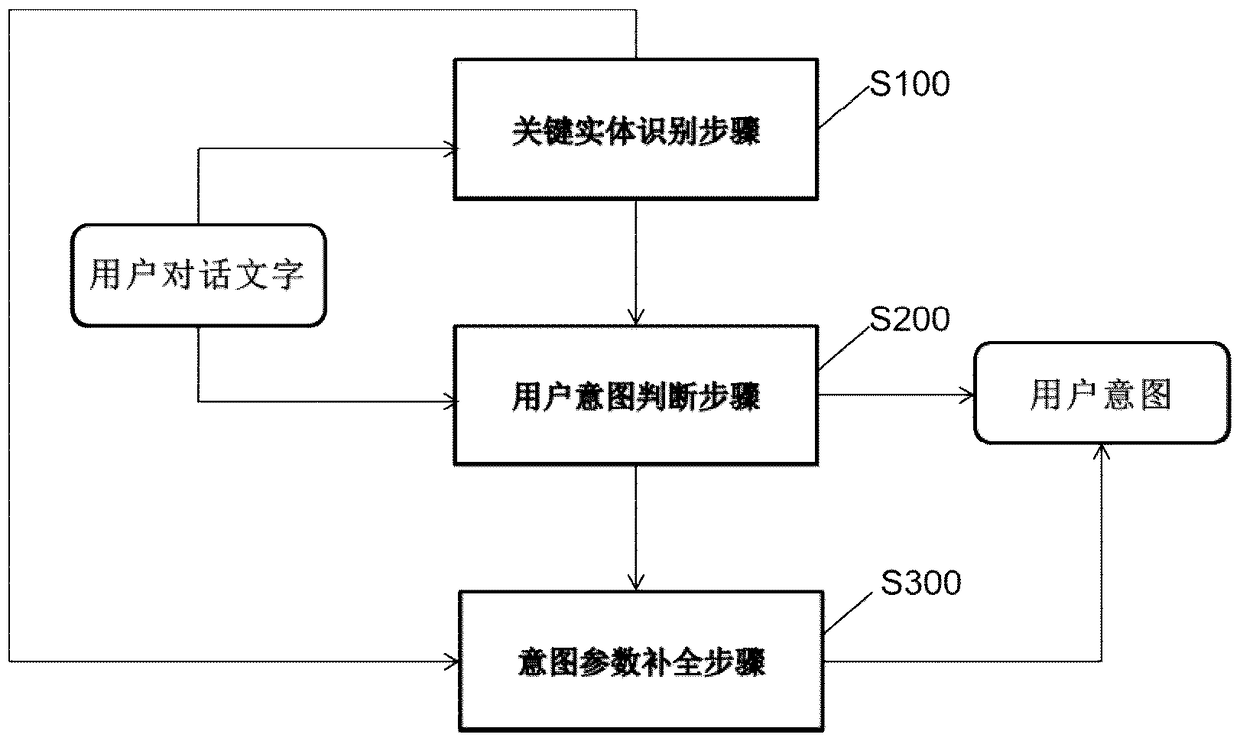User intention identification method and user intention identification system
A technology of user intent and recognition method, applied in special data processing applications, instruments, unstructured text data retrieval, etc., can solve problems such as poor model scalability and inability to understand user business needs, and achieve a comprehensive recognition effect
- Summary
- Abstract
- Description
- Claims
- Application Information
AI Technical Summary
Problems solved by technology
Method used
Image
Examples
Embodiment 1
[0081] This embodiment mainly involves the transfer scenario, for example, "transfer one hundred yuan to my dad".
[0082] (1) Step 1: key entity identification, the implementation steps are as follows:
[0083] 1.1 Word segmentation, part-of-speech tagging, and named entity recognition:
[0084] Give / p me / r dad / n transfer / v a hundred / m yuan / q money / n, the named entity set is empty.
[0085] 1.2 Get intent parameter candidates:
[0086] It can be seen from the word segmentation and part-of-speech tagging results that one hundred dollars is a combination of numeral m + quantifier q + noun n, and the noun "money" belongs to the money intention parameter, then money=one hundred dollars can be set.
[0087] 1.3 Intent parameter candidate standardization:
[0088] Since there are no intent parameters such as country and currency in the named entity collection, the default currency of money is RMB, and money=100 RMB.
[0089] (2) Step 2: Judgment of user intent, the implementat...
Embodiment 2
[0104] Example 2 involves the exchange rate query business scenario: the user puts forward a demand "I withdraw 1,000 Canadian dollars in Canada, and the deduction is more today than yesterday. I want to check the exchange rate?".
[0105] (1) Step 1: key entity identification, the implementation steps are as follows:
[0106] 1.1 Word segmentation, part-of-speech tagging, and named entity recognition:
[0107] I / r in / p 2: Canada / ns took / v / u 1000 / m block / q, / wp today / nt than / p yesterday / nt deducted / v got / u more / a, / wp me / r Want to / v check / v about the / m exchange rate / n? / wp;
[0108] The collection of named entities is {Canada / S-Ns}.
[0109] 1.2 Get intent parameter candidates:
[0110] From the word segmentation and part-of-speech tagging results, it can be seen that 1000 yuan is a combination of numeral m+quantifier q, and the quantifier "chunk" belongs to the money intention parameter, then money=1000 yuan can be set;
[0111] The part-of-speech tag of ...
Embodiment 3
[0132] Embodiment 3 involves the business scenario of introducing preferential activities: the user puts forward a demand "What preferential activities are there for UnionPay cards at Seoul Airport and Incheon Airport in South Korea?".
[0133] (1) Step 1: key entity identification, the implementation steps are as follows:
[0134] 1.1 Word segmentation, part-of-speech tagging, and named entity recognition:
[0135] UnionPay card / n at / pKorea / ns Seoul / ns airport / n and / cIncheon / ns airport / n have / vwhat / r discounts / vevents / v? / wp;
[0136] Named entity collection is empty {Seoul Airport / Ns, Incheon Airport / Ns}.
[0137] 1.2 Get intent parameter candidates:
[0138] From the results of word segmentation and part-of-speech tagging, it can be seen that "what" is used as a question word, and ques_tag=what;
[0139] "Promotion" and "Activity" are saved as the intent parameters of promotional activity introduction;
[0140] The set of named entities is {Seoul Airport / Ns, Incheon ...
PUM
 Login to View More
Login to View More Abstract
Description
Claims
Application Information
 Login to View More
Login to View More - R&D
- Intellectual Property
- Life Sciences
- Materials
- Tech Scout
- Unparalleled Data Quality
- Higher Quality Content
- 60% Fewer Hallucinations
Browse by: Latest US Patents, China's latest patents, Technical Efficacy Thesaurus, Application Domain, Technology Topic, Popular Technical Reports.
© 2025 PatSnap. All rights reserved.Legal|Privacy policy|Modern Slavery Act Transparency Statement|Sitemap|About US| Contact US: help@patsnap.com



